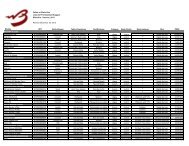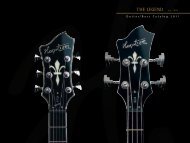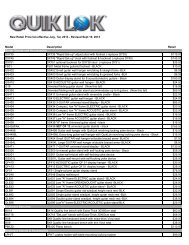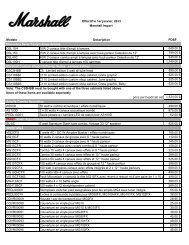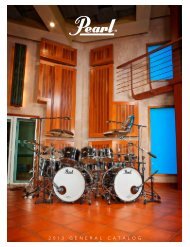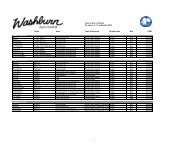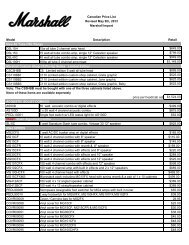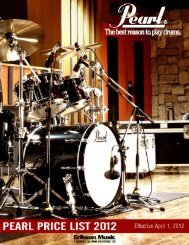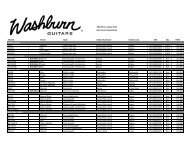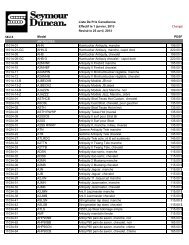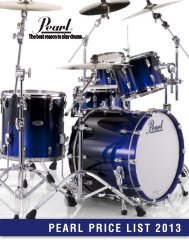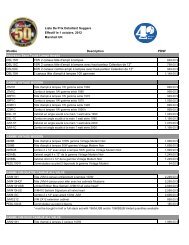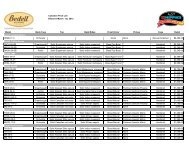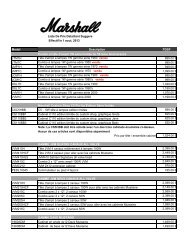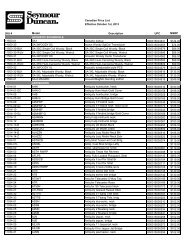How to Pick a Pickup - Seymour Duncan
How to Pick a Pickup - Seymour Duncan
How to Pick a Pickup - Seymour Duncan
Create successful ePaper yourself
Turn your PDF publications into a flip-book with our unique Google optimized e-Paper software.
SEYMOUR DUNCAN<br />
is your relationship with<br />
your guitar on the ropes?<br />
are you constantly fighting with it <strong>to</strong> put out great <strong>to</strong>ne? or maybe you’re<br />
just not getting any. you know, your instrument should love you as much<br />
as you love it. if things between the two of you aren’t working out,<br />
then it’s time for a new pickup.<br />
what’s a pickup?<br />
Technically, pickups are transducers that “pick up” string vibrations and translate them in<strong>to</strong> an electrical current<br />
which then comes out of your amp as a tasty jazz run, a chunky power chord, or an in-yer-face death metal riff.<br />
why change pickups?<br />
Simply put: Are you <strong>to</strong>tally satisfied with your instrument’s <strong>to</strong>ne? Look – 99% of all guitars are built from the<br />
same basic stuff: wood, strings, hardware, and pickups. Each of these components plays an important role in<br />
formulating the <strong>to</strong>ne and determining how your instrument will sound. But check this out – if you’ve got an<br />
instrument that looks right and feels right, but doesn’t sound right <strong>to</strong> you, then the pickups in that instrument are<br />
not the right pickups for you. <strong>Seymour</strong> <strong>Duncan</strong>/Basslines manufactures hundreds of pickup models for all kinds of<br />
instruments with the single-minded goal of helping you find your <strong>to</strong>ne. Your <strong>to</strong>ne.<br />
ok, this is about me. so, how do I choose the right pickups?<br />
First off, determine your <strong>to</strong>ne needs. Do you need more output? Are you looking for a thicker <strong>to</strong>ne? Is your <strong>to</strong>ne<br />
lacking bot<strong>to</strong>m end? Are you in search of more sustain or better dynamics? Answering these questions is the first<br />
step in choosing the right pickup for you.<br />
Next, you need <strong>to</strong> read about the pickups. Think about how the various models presented in our website will<br />
work for you. If you’d like <strong>to</strong> actually hear the electric guitar pickups, grab yourself a copy of The Journey is<br />
the Destination, our three-volume CD series that highlights most of our electric guitar pickups under scientific<br />
conditions. The Journey is the Destination is available from any <strong>Seymour</strong> <strong>Duncan</strong>/Basslines dealer or fac<strong>to</strong>ry<br />
direct. Or, if you’ve got a computer with really good speakers, listen <strong>to</strong> it – for free – on our Soundbytes section.<br />
We strongly advise you check out the great <strong>to</strong>ols we have on our website, like the Tone Wizard who will help<br />
you start off on your pickup quest. You’ll also find a bunch of cool wiring diagrams and detailed drawings of<br />
pickup dimensions – very important, since sometimes guitar manufacturers change their pickup route cavities<br />
without us knowing about it. And you’ll find a User Group Forum with the nicest, most knowledgeable, most<br />
<strong>to</strong>ne-minded folks on the ‘net. There are also FAQs, Q&A with <strong>Seymour</strong>, artist interviews, dealer listings,<br />
newsletters, the Wall of Fame and lots of cool features.
FOR TONE THAT SETS YOU APART<br />
what makes one pickup sound different from another?<br />
Basically, a passive pickup is composed<br />
of two things: a magnet and a coil of<br />
insulated copper wire. The magnet<br />
works <strong>to</strong> magnetize the strings creating<br />
something called a flux field. When the<br />
strings vibrate, the movement of this<br />
flux field creates an alternating current<br />
within the pickup coils. This alternating<br />
current then travels from the pickup<br />
<strong>to</strong> the amplifier. When you crank your<br />
amp, you hear the combination of the<br />
pickup and the amplifier interpreting<br />
the vibration of the strings. When you’re<br />
thinking about how a pickup will sound,<br />
there are a few variables that determine<br />
the way it will transduce the string<br />
vibrations.<br />
coil<br />
A pickup coil is merely a long strand of<br />
insulated copper wire, wound thousands<br />
of times around a bobbin (or coil form)<br />
that has magnetic pole pieces at its<br />
core or a bar magnet at its base. We<br />
use several types of insulation and<br />
several gauges of wire <strong>to</strong> give you<br />
the right <strong>to</strong>ne. The different sizes and<br />
shapes of the bobbins have an impact<br />
of determining how the pickup will<br />
transduce the string vibration. For<br />
instance, a narrow coil that’s close <strong>to</strong><br />
the pole pieces like a Fender ® single<br />
coil results in extended treble response.<br />
A P-90, on the other hand, is shorter<br />
and fatter, yielding a more midrangeintensive<br />
<strong>to</strong>ne.<br />
number of turns<br />
The number of turns of copper wire<br />
wound around the bobbin greatly affects<br />
the performance of the pickup and the<br />
overall <strong>to</strong>ne of your guitar. A pickup<br />
with lots and lots of turns will have high<br />
output, but this output will come at the<br />
expense of dynamics and high end. A<br />
pickup with way <strong>to</strong>o many turns will<br />
actually lose output due <strong>to</strong> resistive losses<br />
caused by excessive impedance. On<br />
the other hand, an under-wound pickup<br />
will come across sounding thin and<br />
weak. Getting the right number of turns<br />
for a great-sounding pickup is as much<br />
art as it is science.<br />
d.c. resistance<br />
and resonant peak<br />
The gauge of wire and the number<br />
of turns on the coil each play a part<br />
in defining the d.c. resistance. D. C.<br />
resistance is resistance <strong>to</strong> the flow of<br />
direct current. Generally, the more turns<br />
of wire, the higher the D.C. resistance,<br />
the higher the output and the lower the<br />
treble response. For single coils, the d.c.<br />
resistance generally ranges from around<br />
6.5k for a vintage <strong>to</strong>ne, <strong>to</strong> 15k for a high<br />
output <strong>to</strong>ne. For humbuckers, the range<br />
is around 7.5k <strong>to</strong> around 16.5k. Though it<br />
may seem that this is the clear-cut way<br />
<strong>to</strong> determine what kind of pickup is best<br />
for you, remember this is only one of<br />
several variables that aid in determining<br />
the <strong>to</strong>ne or voice of a pickup.<br />
Resistance <strong>to</strong> the flow of alternating<br />
current is called impedance and it<br />
changes with frequency. The frequency<br />
where a pickup’s impedance reaches<br />
its highest level is called the resonant<br />
peak. Generally speaking, the higher in<br />
frequency the resonant peak, the clearer<br />
and brighter the pickup’s <strong>to</strong>ne.<br />
The relationship between d.c. resistance<br />
and resonant peak is a great way <strong>to</strong><br />
understand the voice and <strong>to</strong>ne of a<br />
<strong>Seymour</strong> <strong>Duncan</strong> or Basslines pickup.<br />
For example, if you check out the <strong>to</strong>ne<br />
chart you can see that an SSL-2 Vintage<br />
Flat for Strat ® has a significantly higher<br />
resonant peak (9.0 KHz) than, say, a<br />
similar pickup like an SSL-3 Hot for<br />
Strat ® (4.4 KHz).<br />
Based on these numbers, you can easily<br />
see that the Vintage has a much brighter<br />
<strong>to</strong>ne and the Hot has a much fatter <strong>to</strong>ne.<br />
Or, if you see that the Vintage (6.6k) has<br />
a much lower d.c. resistance than the<br />
Hot (16.4k), you will understand that<br />
the Vintage has less output and more<br />
brightness compared with the Hot.<br />
Notice the inverse relationship between<br />
d.c. resistance and resonant peak.<br />
Generally speaking, the higher in<br />
frequency the resonant peak, the clearer<br />
and brighter the pickup’s <strong>to</strong>ne.<br />
We list the D.C. resistance and resonant<br />
peak for almost all of our pickups.<br />
It’s most informative <strong>to</strong> compare<br />
D.C. resistance and resonant peaks<br />
between similar pickups, that is,<br />
between single coils or between<br />
full-size humbuckers for example,<br />
and not across broad categories,<br />
like comparing a single coil <strong>to</strong> a<br />
full-size humbucker. Besides<br />
actually hearing the pickup, this<br />
is the best way <strong>to</strong> figure out<br />
what the pickup is going<br />
<strong>to</strong> sound like.
SEYMOUR DUNCAN<br />
what makes one pickup sound different from another?<br />
Chamfering pole piece magnets<br />
magnet<br />
The magnet brings life <strong>to</strong> the pickup.<br />
We use two different magnet materials:<br />
Alnico and<br />
ceramic.<br />
Alnico, an alloy<br />
which includes<br />
aluminum, nickel<br />
and cobalt (“AL-<br />
NI-CO”), tends<br />
<strong>to</strong> have lower<br />
string pull and<br />
creates a softer<br />
magnet field<br />
which improves<br />
sustain and helps<br />
smooth out the<br />
<strong>to</strong>ne. We use<br />
two different<br />
strengths of<br />
Alnico magnets<br />
-- Alnico 2 and<br />
Alnico 5 -- <strong>to</strong><br />
create two <strong>to</strong>tally<br />
different <strong>to</strong>nes. Alnico 2, which is<br />
slightly weaker than 5, tends <strong>to</strong> have a<br />
smoother, warmer, rounder <strong>to</strong>ne with<br />
softer attack. Alnico 5 has a brighter,<br />
more dynamic <strong>to</strong>ne with a tighter<br />
bot<strong>to</strong>m end than 2.<br />
Ceramic magnets are a blend of<br />
magnetic iron and rare earth materials<br />
like barium or strontium, which is<br />
formed in<strong>to</strong> bars under high pressure<br />
and intense heat. If you are looking<br />
for power and extended range in your<br />
<strong>to</strong>ne, ceramic is the way <strong>to</strong> go. Ceramic<br />
creates a magnet field more powerful<br />
than that of Alnico and is more resistant<br />
<strong>to</strong> environmental aging. We use ceramic<br />
magnets on some of our humbuckers<br />
(like the SH-13 Dimebucker), single coil<br />
sized humbuckers (like the JB Jr.), and<br />
bass pickups (like the active soapbars),<br />
because it produces a more aggressive<br />
<strong>to</strong>ne with a punchier bass end and<br />
enhanced upper mids.<br />
Understanding the relationship<br />
between d.c. resistance and resonant<br />
peak is a great way <strong>to</strong> discern the<br />
“voice” of a pickup. But of equal<br />
importance is understanding how the<br />
magnet of the pickup matches with the<br />
various types of <strong>to</strong>ne woods used in<br />
guitars. Ask yourself this: is my guitar<br />
naturally bright sounding or warm<br />
sounding? Bright sounding guitars will<br />
have a tendency <strong>to</strong> have a pronounced<br />
high-end detail; and warm sounding<br />
guitars will have more emphasis in the<br />
lower-midrange. Certain woods, like<br />
mahogany and rosewood, will often<br />
create a warm sounding guitar. Other<br />
woods, like maple and ebony, will make<br />
a guitar bight sounding. What kind of<br />
wood is used on your guitar?<br />
Here’s the trick: you can balance a<br />
bright sounding guitar with a warm<br />
sounding pickup. And vice versa. Alnico<br />
2 has a characteristic warm <strong>to</strong>ne with<br />
soft attack. Generally, this means it<br />
usually works well with bright sounding<br />
guitars. Alnico 5 and ceramic generally<br />
have a brighter <strong>to</strong>ne than Alnico 2,<br />
which make them well suited <strong>to</strong> warm<br />
sounding guitars. Keep in mind that<br />
these are general guidelines; and we<br />
make some broad-based suggestions<br />
for woods for each pickup in their<br />
catalog description. But some Alnico 2<br />
pickups, like the APS-1 Alnico II Pro for<br />
Strat®, for instance, are actually bright<br />
sounding – not because of the magnet,<br />
but because of the low d.c. resistance<br />
and high resonant peak. See?<br />
It’s all related.
FOR TONE THAT SETS YOU APART<br />
ok, what makes<br />
<strong>Seymour</strong> <strong>Duncan</strong><br />
and Basslines<br />
pickups so good?<br />
it’s the pickups<br />
We have a 100%, no-compromise attitude<br />
about our product. From the hand assembly<br />
<strong>to</strong> the fanatical quality control, we have a passionate<br />
devotion <strong>to</strong> making sure our product<br />
is the best it can possibly be. That’s why so<br />
many guitar manufacturers specify our pickups<br />
as original equipment on their instruments.<br />
That’s why so many artists rely on <strong>Seymour</strong><br />
<strong>Duncan</strong> and Basslines <strong>to</strong> give them their sound. And<br />
that’s what makes you sound so good when you get<br />
<strong>Seymour</strong>ized.<br />
Vacuum wax potting<br />
it’s the people<br />
We’re a company of guitar and bass players. We’ve<br />
been on stage. We’ve been in the studio. And we’ve<br />
spent countless hours practicing in our bedrooms. We<br />
know <strong>to</strong>ne, and we know what it takes <strong>to</strong> give you the<br />
<strong>to</strong>ne you’re looking for.<br />
it’s pleasing you<br />
Our devotion <strong>to</strong> our cus<strong>to</strong>mers starts with our product<br />
development and extends <strong>to</strong> our network of authorized<br />
dealers and our 21-Day Real World Exchange<br />
Policy. It’s all about taking care of you by helping you<br />
find Tone That Sets You Apart. And helping you<br />
patch things up with that axe you know you<br />
love so much.<br />
Each pickup is built by hand<br />
<strong>Seymour</strong> jams with a member of our<br />
Internet forum at User Group Day 2005



